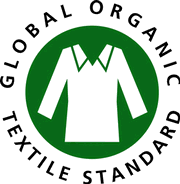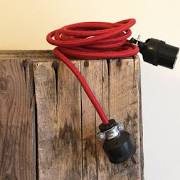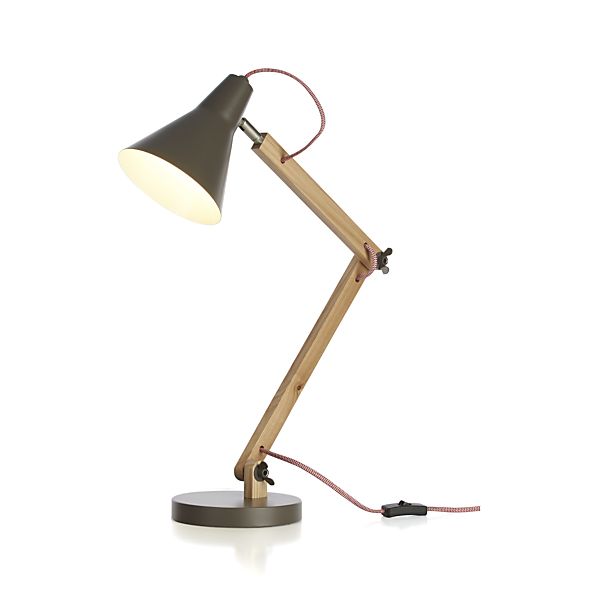
Art | Resources
GOTS Certification for Organic Fabrics
 Today my guest is Karlin Warner, the Textile Certification Specialist for OneCert, Inc., an organic certification company in Lincoln, Nebraska. We’ll be talking about the GOTS certification program for organic textiles, so we can all understand what the standard is and how it is certified when we see the certification seal on a label. Karlin received her B.S. in 2007 and M.S. in 2009 from the University of Nebraska-Lincoln in Textile Science, with a minor in Chemistry. While working on her thesis project, testing an eco-friendly wrinkle resistant finish for silk, she found she had a fascination with the more sustainable side of the textile industry. Starting at OneCert while finishing her degree,
Today my guest is Karlin Warner, the Textile Certification Specialist for OneCert, Inc., an organic certification company in Lincoln, Nebraska. We’ll be talking about the GOTS certification program for organic textiles, so we can all understand what the standard is and how it is certified when we see the certification seal on a label. Karlin received her B.S. in 2007 and M.S. in 2009 from the University of Nebraska-Lincoln in Textile Science, with a minor in Chemistry. While working on her thesis project, testing an eco-friendly wrinkle resistant finish for silk, she found she had a fascination with the more sustainable side of the textile industry. Starting at OneCert while finishing her degree,  Karlin has now worked to certify organic textiles for nearly six years. Her work at OneCert includes reviewing and inspecting applicants to the increasingly popular Global Organic Textile Standards (GOTS), as well as Textile Exchange’s Organic Content Standards (OCS). She likes to travel to work by bike, but also enjoys running, reading, travelling and spending time with her husband and two dogs. www.onecert.com.
Karlin has now worked to certify organic textiles for nearly six years. Her work at OneCert includes reviewing and inspecting applicants to the increasingly popular Global Organic Textile Standards (GOTS), as well as Textile Exchange’s Organic Content Standards (OCS). She likes to travel to work by bike, but also enjoys running, reading, travelling and spending time with her husband and two dogs. www.onecert.com.

TOXIC FREE TALK RADIO
“How Your Body Tells You it has Toxic Overload”
Host: Debra Lynn Dadd
GUEST: Karlin Warner
DATE OF BROADCAST: October 15, 2014
DEBRA: Hi, I’m Debra Lynn Dadd and this is Toxic Free Talk Radio where we talk about how to thrive in a toxic world and live toxic free. It’s Wednesday, October 15th 2014. The sun is shining in beautiful Clearwater, Florida, beautiful autumn day. My guest today is a textile certification specialist who certifies textiles and textile products. She’ll tell us.
What she does is she works with the Global Organic Textile Standard as a certifier. You may have seen the seal on some products or textiles and she’s the one that makes sure it’s organic. So we’re going to learn today about what a certifier does, what makes it organic and anything else she wants to tell us about the certification program.
Her name Karlin Warner and she’s the textile certification specialist for One Cert Incorporated, an organic certification company in Lincoln, Nebraska. Hi, Karlin.
KARLIN WARNER: Hi! Thanks for having me.
DEBRA: Thank you for being on. And I do want to say that I think that your photo – and listeners, if you haven’t seen her photo, if you haven’t been ToxicFreeTalkRadio.com, her photo is lovely. I had to make it small so you can’t see all of it. She’s got a beautiful textile wrapped around her neck. Her photo just really embodies what she does. Good job, Karlin.
KARLIN WARNER: It was actually a gift from a friend. It was blessed I think because of my love for organic cotton. And so it’s an organic cotton scarf and it’s like all natural colors. I love it!
DEBRA: I love it too! I love it too! I just looked at it and went, “That’s beautiful.” Anyway, first of all, tell us all about the Global Organic Textile Standard. Listeners, it’s called GOTS for short. So if you ever hear anybody say GOTS or if you see that in print, it’s the Global Organic Textile Standard. Tell us about that.
KARLIN WARNER: Sure. I guess in a nutshell, the Global Organic Textile Standard – again, GOTS. That’s probably what I’ll call it the rest of the segment is an organic standard that include some other criteria.
It’s not only facing the organic content of a product from these stuff in the supply chain, but it also includes some criteria regarding the toxicity of chemicals that are used. It also includes social criteria. So it’s almost a little bit of a fair trade type of standard that’s included into that. It includes environmental and waste products [inaudible 00:03:53] as well.
It’s interesting that it’s called a ‘global standard’ because it’s used globally, but it’s also all-encompassing. It includes a lot of different pieces to make a really good quality product.
DEBRA: There’s other questions I want to ask you, but I just want to jump in with this one and ask isn’t it difficult to be evaluating all those different things?
I know for myself, I understand the different things that you’ve just described, the environmental effects and fair trade and everything. And as a consumer advocate, there’s a point in my life where I said, “Well, I need to consider all these things, but it’s just too difficult for me to evaluate products and have” – at least at that time, I think things have changed. It was just too difficult to say, “Well, something has to be non-toxic and fair trade and environment and recycled” and whatever it happened to be. I ended up with nothing to qualify for all those things.
I think the situation has changed now because this is about 15 years ago I was trying to do this. But I finally decided I’m just going to take one thing. I’m just going to look at toxics and make sure that people can identify what’s toxic and then if they want to look at those other aspects or I should say, what’s toxic free. And if they wanted then to look at those other aspects, they can. But for me, I think that toxicity is the important thing.
Do you really find in your work that you can evaluate all those things and find products obviously that meet all those standards?
KARLIN WARNER: I do think it’s possible. It definitely has been a learning curve me. I came to this with a textile background, so I had to learn a lot about how to evaluate the social criteria and other aspects.
I think if you didn’t have a standard that you’re evaluating something to, it would be really difficult to, like you’ve mentioned, know that it’s not toxic and that it’s fair trade and that it’s organic. It gets complicated to keep track of all of those pieces. But having one standard that has all the criteria does make it a little bit easier.
DEBRA: Yes, I think that people knew that about the GOTS standard, that it encompass all those things, then they could say, “Oh! Well, now this is covered. If I see that seal, I know that it’s non-toxic, that it has environmental benefits, it’s fair trade. That’s encompassed in the standard.
So how did you get interested personally in being a certifier?
KARLIN WARNER: Well, like I mentioned, I went to school for textile. My degree is in textile science so it was a lot more on the chemistry and textile testing side of the textile industries.
And while I was finishing my master’s degree, I was working on a thesis project for a more eco-friendly and less toxic wrinkle-free finish for silk. So it was a finish that was primarily using the citric acid the active ingredient rather than formaldehyde.
And so doing the research for that project really got me thinking about what other things could we be doing differently if you want less toxic and if you want to make less of an impact to the environment.
And so through like an email list or something, I got asked if I was interested in helping OneCert get their organic textiles program started and rolling because they were just starting to grow it out of that point.
So I started part-time while I was working on my degree. And then it’s pretty much history from there. I just found that I really liked it. I kind of just went with it.
DEBRA: Well, sometimes those things just appear in life, those right things. While you were talking, I was thinking that consumers, that your job in a way, you’re a certifier, your job is to say, “This product, it meets this standard.”
But as consumers, we kind of go through the same process in terms of saying, “Well, we want something that’s, say, toxic-free.” Then we have to be able to have our own standard and say this product doesn’t have this and this and this in it.” And so in a sense, we’re all certifiers. We’re certifying to ourselves and that for everybody, there needs to be a standard.
So tell us something about the Global Organic Textile Standard specifically about toxics. What are they looking for?
KARLIN WARNER: Sure! I guess the most specific part about toxic in the Global Organic Textile Standard is the prohibited and restricted input. So within the standard, there is a list of chemical ingredients that cannot be used in processing of these organic textiles.
So, for example, I already mentioned formaldehyde and that’s one of them, and genetically-modified organisms should not be used and heavy metals, plasticizers like phthalate (that’s been in the news a lot lately). There’s a whole list of these things that cannot be used.
So that’s one part of it. GOTS prohibits these chemicals specifically. And then those that aren’t explicitly listed also have to be evaluated according to some additional studies. [Inaudible 00:09:56] additional criteria mostly relating to aquatic toxicity and oral toxicity and biodegradability.
DEBRA: So what you’re doing is that you’re looking to make sure that a product does not contain the prohibited list. But then there might be some other chemicals. And so if other chemicals are being used, you need to evaluate their toxicity?
KARLIN WARNER: Yes, yes. So even if it’s something that’s not on the prohibited list, it still has to meet these other criteria.
DEBRA: Yeah. Yeah, you know that’s very similar to what I do as a consumer advocate, but I’m not a certifier like you are. We need to go to break, but we’ll talk more about this when we come back.
You’re listening to Toxic Free Talk Radio. I’m Debra Lynn Dadd and my guest today is Karlin Warner, textile certification specialist for OneCert in Lincoln, Nebraska. We’ll be right back.
= COMMERCIAL BREAK =
You’re listening to Toxic Free Talk Radio. I’m Debra Lynn Dadd and my guest today is Karlin Warner. She’s a textile certification specialist for OneCert, an organic certification company in Lincoln, Nebraska.
So Karlin, actually, we’re having some static on the line. Can you say something just as a little test? Can you speak up a little louder than you’ve been speaking and we can get rid of that static?
KARLIN WARNER: Sure, I can speak up a little bit more.
DEBRA: Oh, great! That’s perfect. Okay. So now, when you are going through the process of certifying, tell us what do you get to do as a certifier because I know that as a consumer advocate, I’m pretty much limited to what the advertising is about a product and what are the listed ingredients. What are the selling points and things like that?
I’ll go to a website and it has information, but it’s not necessarily the whole story. And a lot of times, when I ask questions, manufacturers are reluctant to give me information.
But as a certifier, you need to be able to see everything that’s going on I’m assuming so that you can make your evaluation. Is that right?
KARLIN WARNER: Yes, that’s correct. Actually, anybody that’s applying for certification with us has to agree to share any information with us. So they submit to us a plan of how they are going to meet the organic standard. And then we evaluate that plan through the criteria to see how well it meets it and see if there’s anything that they need to change.
We also do an on-site inspection and I think that’s where a lot of the important things really happen because then we get to see really behind the scenes how things are actually being done and if it matches what they say is doing, we can see what inputs are actually being used and we can see their record-keeping and see how well things are documented as far as traceability. We want to know that the organic material they say they’re using is actually being used in that product. And same thing with the chemicals and the [inaudible 00:16:09].
DEBRA: This is so interesting. Can you just give us more details like a walk through in those descriptions? You don’t have to tell us what the product is you’re describing, but just so that listeners can get a real idea?
KARLIN WARNER: You mean a walkthrough of the inspection process?
DEBRA: Just give us more details of what you’d do if somebody came to you and said, “I want to get a certification.” The first thing that you will do is…
KARLIN WARNER: Oh, okay.
DEBRA: Just part of what you’ve just said, but more detail. So what it’s like? When you go through the inspection process, what are the kinds of things you’re looking for? What do you see? I just want us to all have more reality on when somebody sees that it says it’s ‘certified organic’, what does that actually mean?
KARLIN WARNER: Okay, absolutely. So if it’s certified organic, that means that it has been evaluated by a third party. So it’s one thing if the manufacturer says, “This is organic,” but they don’t have anything extra to back up that claim. So that’s what we do.
So we’re an external third-party. We don’t have any other relationship with the client. They will submit an application to us. And as I’ve mentioned before, that’s their plan for complying with the organic standards. They submit details about where they’re getting their organic fiber. They submit details about what chemicals are going to be used and if they’ve been pre-evaluated for GOTS to use.
They submit maps and layouts of where things are stored and how organic products are separated from non-organic product, maybe their record-keeping practices. And then again, all of the social criteria so they will have to provide policy other than that they meet the social criteria, which is again, the more so fair trade item.
So we review that entire application in detail. That’s when we might some little things that, a crack or sometimes, we’ll find some big things that are really big, red flags and would mean that they can’t be a client.
That’s the main review. And then after that, we go do the physical inspection. So we’ll go through their warehouse or their mills depending on what type of processing they are doing. We take a checklist, then we walk through the entire process.
Basically, what I do is have them walk me through every step that they take from the raw, organic product coming in to their finished product. And so we can really see what is being done every step.
And we might collect samples for testing. We might collect copy of the records and things like that as well.
And then after the inspection, we perform another review. We determine if they’re compliant. And if they are, then that’s when the certificate is issued.
So all in all, the certification process will typically take two months, maybe three. It really depends on how complete the application is to begin with. That’s the certification process in a nutshell.
I find that a lot of my work is at a desk reviewing inputs and working at maths and reviewing test reports and a lot of those tendered documentations. I really enjoy when I get to go out into the field and do the inspection. That’s kind of fun.
DEBRA: Yeah, I imagine it would be. I know I like to go to organic farms and visit and go to factories and see what they are doing. It can be a lot of fun to do that.
So we’re coming up on the break pretty soon, so I don’t want to ask you another one question. But I think that when people see that something has been certified, that they don’t really understand everything that has really gone into it.
It just is amazing to me how when somebody has to make a plan, it’s like – I know that if I were to make a plan of everything that I was going to do, say, to take a trip to go someplace and that I would have to list every single detail, that would be very difficult.
Just the action of making a plan and saying, “This is how we’re going to do everything” and then doing it exactly according to plan. That’s a pretty amazing thing right there. Just right there, that’s an amazing thing.
So we’re going to go to break and we’ll be right back. This is Toxic Free Talk Radio. I’m Debra Lynn Dadd. My guest today is Karlin Warner. She’s the textile certification specialist for OneCert, an organic certification company in Lincoln, Nebraska. We’ll be right back.
= COMMERCIAL BREAK =
DEBRA: You’re listening to Toxic Free Talk Radio. I’m Debra Lynn Dadd. My guest today is Karlin Warner. She’s the textile certification specialist for OneCert, an organic certification company and she certifies textiles to the Global Organic Textile Standard.
Karlin, I wanted to ask you to explain about the difference between a GOTS certified fabric or a fabric that says that it’s organic. Is there a difference? And then what if a product says that it’s GOTS certified. What do all of those things mean? How does a consumer know what to look for in a textile?
KARLIN WARNER: Well, the best way to know if something is GOTS certified is to look for the logo. If you aren’t familiar with the GOTS logo, it’s kind of a green circle with a white colored cert kind of tape in the middle underneath. So it’s Global Organic Textile Standard around the outside.
DEBRA: And ToxicFreeTalkRadio.com in the description of today’s show, I put the logo so that everybody can see it and recognize it.
KARLIN WARNER: Oh, perfect. Perfect! Well, you can take a look at it there. That’s the best way to identify a fabric or a finished product that’s GOTS certified.
And sometimes, you might find that there are some false claims out there. So if you’re worried that a product is labeled as GOTS certified, but it might not actually be, the best thing that you can do is you go to the GOTS website, which is Global-Standard.org and they actually have a public database of all of the certified operations online. So you can search for the company or the manufacturer identified along with that label.
DEBRA: So if somebody were to see a GOTS certification on a fabric, then that means that the fabric itself – here’s what I want to clear up. If you see USDA on a label, then what the USDA organic certification is for is they’re certifying the agricultural product, the agricultural material. They’re not actually certifying the product, right, in textiles?
KARLIN WARNER: In textiles, actually, I do not think that he USDA allows their logo to be used on textiles unless the entire processing of the textile product has been done according to their standards, which as you know, have been written for food. So it’s very difficult. It supposedly can be done, but it is very difficult.
DEBRA: Well, isn’t that why GOTS was invented?
KARLIN WARNER: Right!
DEBRA: So that there would be a standard specific for the manufacturer of textile products.
KARLIN WARNER: Right, because there’s a lot of differences between food and dying fabric. There are things that we will wear that we wouldn’t put in our mouth and probably vice versa, so it makes sense to have different standards.
So the raw fibers for that is used in the GOTS products could’ve come from USDA certified field or other equivalent organic standards. But that’s basically the extent of certification of textiles under the standards.
DEBRA: So I guess the point I’m trying to make is that somebody could say, “This is organic fabric” and then they might produce a certification that says that this cotton is certified organic as an agricultural product, but it doesn’t say anything about how the fabric was produced.
KARLIN WARNER: Right. It’s the ingredient basically.
DEBRA: Right. And so where GOTS is important is because it has as standard for the entire production of that fabric.
KARLIN WARNER: Yes, everything from getting to the finished product and even through importing and distribution. Those are all parts that are certified. So really, the only ones that don’t have to be certified are the retailers. And that’s only apparent doing any processing.
DEBRA: Right, this came up actually on another show where we’re talking about organic personal care products. The person I was interviewing was talking about the importance of certifying the retailers. In a food setting – and you can tell me if this applies or not in a textile setting, but in a food setting, you could do something in a store, you could take a natural food store, you could take an organic lettuce out of the bin and bring it over the deli section or their little restaurant and that they could say, “This is organic salad now,” but they aren’t certified to prepare that salad in an organic way.
KARLIN WARNER: Right, right. They could do something in the preparation step that would make it not organic if they’ve actually been certified.
We run into that a lot with t-shirt products, for example. We have a GOTS certified t-shirt, someone picks it and prints on it. And then they want to control it as GOTS certified, but technically, they can’t.
DEBRA: Right, that’s a very good example. That’s a very good example. And particularly with toxics, that’s a very good example because here, you have this GOTS certified organic t-shirt and then they put a toxic ink that is emitting toxic fumes. That’s not a GOTS certified product.
Are you there?
KARLIN WARNER: Yes, I am here.
DEBRA: Oh, okay. I thought maybe we might have dropped the line. I didn’t hear you.
Okay, so something like if it was a GOTS certified organic t-shirt unprinted and then they print it with a toxic ink that’s now out gassing toxic fumes, that is not a GOTS certified t-shirt.
KARLIN WARNER: Correct. Right, that would make it not GOTS certified.
DEBRA: Right. That’s a really good example.
And so then, when we get to the level of a product, you can also certify a product. I know on my website, I list NaturePedic, which is GOTS certified to make mattresses and the whole entire mattress is certified.
KARLIN WARNER: You can have GOTS certified mattresses. That’s something that’s been popping up a little more often lately. GOTS does allow certain other ingredients to be used other than the organic fiber, so that can allow, for instance, the frame and support and different parts of the mattress.
DEBRA: And so would you have other kinds of products that are being certified like clothing or something where they would have to use buttons or zippers or things.
KARLIN WARNER: Yeah, there are a lot of clothing items that use buttons and zippers, even if it has an embroidery thread and other fiber materials have to be kind of evaluated.
DEBRA: Well, we’ll talk more about this after the break. You’re listening to Toxic Free Talk Radio. I’m Debra Lynn Dadd. My guest today is Karlin Warner. She’s the textile certification specialist at OneCert and she certifies textiles and textile products to the Global Organic Textile Standard. We’ll be right back.
= COMMERCIAL BREAK =
DEBRA: You’re listening to Toxic Free Talk Radio. I’m Debra Lynn Dadd. My guest today is Karlin Warner, textile certification specialist for OneCert. It’s an organic certification company in Lincoln, Nebraska.
Karlin, what are some of the things that might come up when you’re reviewing the plan? What are some of the things that you might see that need to be corrected?
KARLIN WARNER: Well, it can really vary depending on what the operation is involved in. One of the biggest things I would say is they have listed input, chemical inputs whether it’s dyes or other textile axillaries that are not GOTS approved.
The way that that is done is that the manufacturers of these textiles input actually submit information to certifiers like myself and we review them and they get put on a positive list for that company. So they’re essentially pre-approved or prescreened.
DEBRA: So these are chemical ingredients I should say where there is a positive approved list, so that as a certifier, all you need to do is go down the list and say, “Oh, this is already approved, so therefore it’s approved in the product.”
KARLIN WARNER: Yes.
I think that that’s a really important point to make for consumers because I’m always looking at, “Well, how do professionals like you, how are you evaluating products because I’m having to evaluate products as a consumer advocate, but then the consumer down the line, every single consumer is evaluating products.”
And so this whole idea of the preapproved positive list is just as important if not more important than the preapproved negative list that’s approved to be negative – how would you say that? Approve a list of positive things? It’s the prohibited list. So there’s the prohibited list and then there’s the positive, okay list.
I think that I know for myself whether I write that list down or not, that I have that list in my mind of chemicals I’m absolutely not going to use and things that I know are okay. I think that if every consumer would think in those terms, I think it would be easier to organize our thoughts about it.
KARLIN WARNER: Yeah, I do think it’s a helpful way to think about it. And definitely, I appreciate having the positive list and the not-allowed list as a certifier because it makes things a lot more black and white. We know that it’s already been evaluated. It either is or isn’t allowed.
DEBRA: Yeah. Yeah. Yeah, yeah. Very good. Okay, so sometimes you see things as you’re evaluating the plan, you see something that isn’t on the approved list, but isn’t on the restricted list either?
KARLIN WARNER: Yeah. So sometimes we’ll come across some inputs that the company has been using for a really long time and they like and they’ve been told that it’s eco-friendly or they’ve been told that it’s fine or it’s compliant, sometimes they’ve even has been told that it meets the GOTS criteria, that’s not sufficient. We need to know that it has been evaluated in detail by a certifier in order for it to be used.
DEBRA: Oh, so your positive, approved list, each of those things have been evaluated by a certifier and that’s why it’s on the positive approved list. So there could be something that meets the qualifications for the positive approved list, it just hasn’t been certified.
KARLIN WARNER: Right. And so in that case, then I always encourage our clients to talk to their suppliers, have their chemical suppliers submit it for approval to a certification body.
It’s a fairly simple process. We just have to take a look at the formulae and we need to see all of the ingredients and [inaudible 00:42:52] with some important pieces of data about the toxicity and biodegradability and stuff like that.
But yeah, I would say that that is the biggest roadblock that we come to with people that are doing processing, like the dying and printing.
DEBRA: Yeah, yeah. Well, tell us what are the different aspects of the process of making a textile that you’re looking at? You start with the raw material and you end up with a piece of fabric, but what are the different steps that it goes through where you might be encountering toxic chemicals?
KARLIN WARNER: Sure! Okay, so the first step is usually for cotton is spinning. It is mechanical and there’s usually no input at that stage.
But if you’re working with organic wool, the first stage is scouring. So right away, the first next processing step, you will encounter input. So right there, there’s usually a lot of detergent-type of chemicals that are used and so that’s something that we have to look at.
Typically, the next stage would be spinning the wool, cotton, silk or whatever fiber we’re working with. Sometimes, a wax or some similar lubricant type of thing might be used in the spinning process. The same thing for knitting and weaving. Sometimes, there are some [inaudible 00:44:29] that are used.
And for weaving, sometimes the yarns are [inaudible 00:44:33] so they’re actually coated in something to make them stronger during the weaving process. That’s something we have to look at.
And then we start to get into more of the wet processing stage. Just like I mentioned, the dying and the printing and the finishes that is a wet ingredient. There’s obviously a lot of chemicals.
And one other one that I would…
DEBRA: And… sorry, go ahead, yes.
KARLIN WARNER: It’s important for the organic consultants because a lot of times, if you do the sizing for weaving, then a lot of times, they use organisms to remove the sizing materials. So we have to make sure that they’re using GMO-free organism for that.
DEBRA: Hmmm… so if the organisms are not GMO-free (like they probably would be for anything that isn’t certified by you), then those GMO’s affect the end user in a way? Are they still there on the clothing?
KARLIN WARNER: I don’t know if I can answer that it’s 100% preserved, but it’s usually enzymes that are used. It’s because they can break down the starches that are used for sizing. I’m not sure if it leaves any residue, there’s always a possibility. But I think in the main, we just doesn’t like to use GMO at any stage. That’s something that is definitely prohibited. It’s more of the classic, old template.
DEBRA: Yes, yes. I mean, this is like GMO-free textiles and I think that that’s a good thing. I just think that we shouldn’t be using GMO’s at all for anything. They’re unnatural.
KARLIN WARNER: Yes, exactly.
DEBRA: Yeah, yeah. There’s no need really to use them. So once something goes through this whole process, then you issue the certification.What about marketing of this? Is there anything besides labels or anything that GOTS is doing to help consumers understand it better or look for the label?
KARLIN WARNER: I think it’s an ongoing process and they’ve been trying to do a little bit more consumer awareness. But it’s something that I hope grows a lot more in the next coming year.
I know in the Europe the GOTS label is actually fairly recognizable. But here in the U.S., it’s kind of rare to see. It hasn’t really caught on enough to get a whole lot of consumer awareness.
But aside from using the logo and encouraging certifiers use the logo. There are some other campaigns out there about using organic cotton. I don’t know if you’ve seen that Cottoned On campaign. I think it was [inaudible 00:47:50]. It’s kind of related to the GOTS standard-based [inaudible 00:47:56].
DEBRA: Could you say that again because you kind of broke up and I didn’t get it. What is the other standard?
KARLIN WARNER: Oh, it’s not a standard. It’s like a campaign. It’s like a marketing campaign for organic cotton. They just call it Cottoned On.
DEBRA: Oh, I haven’t seen that.
KARLIN WARNER: So they say, “Have you cottoned on?” It’s kind of an interesting website. I encourage you to check it out.
DEBRA: And it’s just CottonedOn.com.
KARLIN WARNER: I believe so.
DEBRA: Oh, is that it?
KARLIN WARNER: I looked at it yesterday,but I can’t remember.
DEBRA: Okay. Okay, good. Yeah. Alright! Well, we’ve reached the end of the show. Is there any final words that you’d like to say about anything we haven’t covered?
KARLIN WARNER: I don’t think so. I think we’ve pretty much covered it all. I don’t really have anything to add at this point unless there’s something that you have to ask?
DEBRA: Well, no. We actually have less than a minute left anyway. But thank you so much for being here. I think that we’ve learned a lot today about what the certification process is about.
That’s Karlin Warner. She’s with OneCert. Their website is OneCert.com. This is Toxic Free Talk Radio. I’m Debra Lynn Dadd and you can go to ToxicFreeTalkRadio.com and find out more about the different shows that are on. You can listen to those shows, the previous shows. You can find out who’s going to be on tomorrow. You can also go across the top. There’s a menu that shows different parts of my website. One of them, you just click on Shop and you’ll see that as you go through it that there are different websites that sells GOTS certified textile products of various types and all kinds of toxic-free products. I have more than 500 websites listed there where you can buy toxic-free products and live without exposure to toxic chemicals that we’re talking about every day on the show.
So please join me again tomorrow. Listen to the shows whenever you’d like 24 hours a day. This is Toxic Free Talk Radio. I’m Debra Lynn Dadd. Good bye.
Removing Odor From Car Interior
Question from edward
I have a Honda accord 2010, seats are fine as they are leather, but the plastic/vinyl dashboard and carpet although 2010 is still, strong.
I’m looking for something non toxic odorless to neutralize and give fresh air. Have tried ozone/ultra violet treatments and it works for a week only, fresh air and sun.
Debra’s Answer
I contacted OdorKlenz to see if any of their products would work for this. Here is their reply:
We have had Customers use our OdorKenz Skunk or OdorKLenz-S to remove fragrances and odors from their cars. If they are able to use a carpet extractor then I would go with the OdorKlenz-S to get the rugs and upholstery done but if it is a simple wipe down and cleaning then the OdorKLenz Skunk would be fine. Both will work in this case just a matter of personal preference. Your readers can use code Savings1 at checkout to receive 30% off .
Microbial Shield
Question from Donna
Hi Debra,
We recently found mold in our basement and used a company to clean and remove it with a hydrogen peroxide formula. We have used this company before, as they do excellent work, and have had no problems with their products (my son has chemical sensitivities).
However, there was a coffee table in the basement which I was planning to use upstairs in the family room, and it got coated with their microbial shield. They say the main ingredient in the shield is a food preservative, but I am concerned as the table will be touch a lot and probably eaten off of.
Attached is a link to their MSDS. Do you think this is safe? Would coating the table with AFM Safecoat help? Thank you as always! Donna
Debra’s Answer
According to their MSDS, the microbial shield contains 2-butoxy ethanol.
It’s in the NIOSH Pocket Guide to Chemical Hazards
Symptoms irritation eyes, skin, nose, throat; hemolysis, hematuria (blood in the urine); central nervous system depression, headache; vomiting
Target Organs Eyes, skin, respiratory system, central nervous system, hematopoietic system, blood, kidneys, liver, lymphoid system
Remember this is for workers who are having direct contact with this chemical.
This is a volatile organic chemical (VOC), so it may be that it has already evaporated. If so, and all that’s left is the food preservative, it should be fine.
If you feel safer coating it with AFM Safecoat, go ahead. That would give you a finish that you know is safe.
Pillows
Question from Cindy
I’ve read so many conflicting things on the Internet about pillows. Some say pillows cause neck pain, while others say you must have a pillow to support your neck & that it’s the size of the pillow that makes the difference. What are your thoughts on this, & what kind of pillows would you recommend, if you do? Thank you so much for all you do.
Debra’s Answer
This isn’t really a toxics question, and I’m not a chiropractor, but I can tell you my experience.
For years I have been sleeping on a regular pillow with a neck roll. I love this neck roll so much I take it with me when I travel. I put it under my neck and then my head is on the regular pillow. No neck pain with this.
I have pillows from Shepherd’s Dream and USAlpaca. My neck roll is from Shepherd’s Dream.
I recommend any pillows made with natural fibers that you are comfortable with. You can find natural fiber pillows on the Beds & Bedding page of Debra’s List and the Bedding Only page of Debra’s List.
Crypton Super Fabrics
Question from Stacey
Hi Debra,
I am trying to find a less toxic carseat/booster seat for my children. I did check Healthy Child but the list is outdated and I question the testing and results since the same brand can have the safest and worst car seat listed…
I did find some seats made by Clek Olli that are made of “Greenguard Crypton Super Fabrics” which “provide permanent protection against stains, moisture and odor-causing bacteria and are free of brominated and chlorinated flame retardants.” Of course I like that it is supposedly free of these flame retardants, but I wonder about the safety of other chemicals used to make it stain, odor, and microbial resistant. Have you heard of Crypton Superfabrics or have any recommendation about it’s safety? All car seats and boosters seem pretty toxic, so I feel it’s just a guessing game choosing a safer car seat, if that’s possible. Thanks so much, Debra, for all the great advice!
Debra’s Answer
It took me a while to find the information on this product, but I found it at www.hytex.com/pdf/Crypton.pdf.
This is considered a “green” product.
There are four requirements for creating
new collections:
01. Select fiber content that is either:
(a) 50-100% recycled
(b) 100% heavy-metal-free polyester
(c) 100% wool with heavy-metal-free dyes
(d) 100% polypropylene
We don’t know which fabric is on your carseat, but any one of these is better than most other carseats.
Read more at the link about how these fabrics must meet emissions standards.
It is GREENGUARD Indoor Air Quality Certified and GREENGUARD Children & Schools Certified. It’s also has the SCS Indoor Advantage Gold certification and the “Cradle to “Cradle” certification, which disallows a whole list of toxic chemicals.
What I can say is given the type of product you are considering, this choice is very probably a lot less toxic than most others on the market.
Here’s the thing for me. Would I sleep on this fabric? No. I just don’t go near synthetic fabrics of any kind, toxic or not toxic. Synthetics just make my skin creep. I’d use the wool version.
But absolutely it’s a better choice than most other carseats.
Lead-Free Cloth Extension Cords
Question from STAR
Hi,
I was wondering where I could purchase lead free etc. extension chords.
Thanks!
Debra’s Answer
I’m so glad you asked this question! I just struck a gold mine of possibilities for you.
I searched on “lead-free extension cord” and got zero results.
Then I tried “cloth extension cord” and bingo!
Why are we concerned about lead on extension cords? Because virtually all extension cords and cords of any kind contain lead, known to the state of California to cause cancer. Many products now carry this warning:
WARNING: Handling the power cord on this product will expose you to lead, a chemical known to the State of California to cause [cancer and] birth defects or other reproductive harm. WASH HANDS AFTER HANDLING
All power cords for all products. All extension cords, All surge protectors.
It takes only seconds for your skin to absorb lead from touching cords, lead paint, or anything else containing lead.
The European Union has ban[ned] the placing new electrical and electronic equipment on the EU market containing more than agreed levels of lead, cadmium, mercury, hexavalent chromium, polybrominated biphenyl (PBB) and polybrominated diphenyl ether (PBDE) flame retardants.” Their cords are RoHS (Restricion of Hazardous Materials) compliant.
But I couldn’t find any internet source of RoHS compliant cables available for consumer purchase. There’s a business someone should start.
So cloth-covered cord is the solution for the moment. You can even find some products now with cloth-covered cord, like this lamp I bought from Crate & Barrel.
Calcium—Is There Really a Deficiency in America?
 My guest today is Pamela Seefeld, R.Ph, a registered pharmacist who prefers to dispense medicinal plants. Today we’ll be talking about calcium, osteoporosis, boneloss….Should you be taking calcium at all, and if so, how much and in what form? And what happens to your health if you take too much. Pamela is a 1990 graduate of the University of Florida College of Pharmacy, where she studied Pharmacognosy (the study of medicines derived from plants and other natural sources). She has worked as an integrative pharmacist teaching physicians, pharmacists and the general public about the proper use of botanicals. She is also a grant reviewer for NIH in Washington D.C. and the owner of Botanical Resource and Botanical Resource Med Spa in Clearwater, Florida. www.botanicalresource.com
My guest today is Pamela Seefeld, R.Ph, a registered pharmacist who prefers to dispense medicinal plants. Today we’ll be talking about calcium, osteoporosis, boneloss….Should you be taking calcium at all, and if so, how much and in what form? And what happens to your health if you take too much. Pamela is a 1990 graduate of the University of Florida College of Pharmacy, where she studied Pharmacognosy (the study of medicines derived from plants and other natural sources). She has worked as an integrative pharmacist teaching physicians, pharmacists and the general public about the proper use of botanicals. She is also a grant reviewer for NIH in Washington D.C. and the owner of Botanical Resource and Botanical Resource Med Spa in Clearwater, Florida. www.botanicalresource.com
LISTEN TO OTHER SHOWS WITH PAMELA SEEFELD
- Vaccines: Harmful or Necessary?
- Evaluating A Study and Testing a Test
- Seven Deadly Drugs
- The Hidden Dangers Affecting Your Heart and How You Can Protect It Naturally
- What We Can Do About Cancer
- The Power of pH
- How to Protect Your Health From Toxic Mercury Dental Fillings
- Pharmacology 101: How to Use What Pharmacists Know to Take Supplements to Best Advantage
- Are You Heading For Kidney Failure? Natural Remedies Can Help
- How to Keep Your Blood Vessels Open and Flowing With Supplements
- How Inactivity Leads to Illness and Drug Use—And How Exercise Can Get You Off Drugs and into Health
- How to Protect the Environment from Pharmaceutical Pollution by Using Natural Medicinals
- Hidden Toxic Dangers in Common Dietary Supplements
- See More Clearly with Natural Remedies
- Hidden Mental Health Dangers in Common Drugs
- Different Types of Detox
- Getting Off Prescription Drugs with Natural Remedies
- How Natural Remedies Could Have Saved A Life
- Natural Alternatives to Sleeping Pills
- Natural Back Pain Treatment Options That Work
- How Toxics Age Your Body & What You Can Do to Stay Young
- You CAN Lose Weight—Even if You’ve Had Difficulty Losing Weight Before
- It’s Cold and Flu Season—How to Support Your Immune System and Why You Shouldn’t Get a Toxic Flu Shot
- How Eating Fruits and Vegetables Help Your Cells Create Health
- Toxic Psychiatry and How to Have Mental Health Without Drugs
- Why You Should Take Fish Oil and How To Choose the Right One for You
- Medicinal Plants Can Replace Toxic Drugs
TOXIC FREE TALK RADIO
Calcium – Is There Really a Deficiency in America?
Host: Debra Lynn Dadd
Guest: Pamela Seefeld
Date of Broadcast: October 08, 2014
DEBRA: Hi, I’m Debra Lynn Dadd. This is Toxic Free Talk Radio where we talk about how to survive in a toxic world and live toxic-free.
It’s Wednesday, October 8, 2014. It’s a beautiful day in Clearwater, Florida. Oh, my God, we’re coming into our autumn and our winter where it’s not humid and the days are beautiful. I’m just out looking in my garden. I was clearing out my bed so that I can plant trees because they grow over the winter. It was just beautiful. It was just exactly the right temperature. The reason people live in Florida is the weather like today, which is great.
My guest today is Pamela Seefeld. She’s a registered pharmacist. She prefers to dispense medicinal plants, instead of drugs. And she really knows what she’s doing. Today, we’re going to be talking about calcium, and what types of calcium. We’re going to be talking about osteoporosis, bone loss, all those kinds of things. But before we do that, we’re going to talk about me for a minute.
Hi, Pamela.
PAMELA SEEFELD: Hey! It’s great to be here.
DEBRA: Thank you. Actually, I wanted to say that I have Pamela on every other Wednesday because she has so much information and so many different things that we can talk about. You can go to ToxicFreeTalkRadio.com and see the list of links to her past shows every other Wednesday. So it’s going to be two weeks and four weeks, and six weeks and eight weeks and we’ll just continue to talk about how we can be healthy by using natural supplements instead of drugs.
I want to say actually so I don’t forget also that the difference between taking drugs and taking the supplement – from Pamela – is that drugs might control your symptoms, but they’re not healing your body. The kinds of things that she gives me and her other clients are things like homeopathic remedies. She’ll tell you about it.
They’re actually healing my body. I can tell that they’re healing my body because the last time we were together, I was talking about how I was sleeping better because I was taking passion flower. And what happened in the last couple of weeks – mid-last week – is that one night, I just fell asleep and before I even thought to take the Passion flower and I slept through the night. I thought, “Okay, the next night, let’s just see if I can just fall asleep.” And for the past week— I’m somebody who just had trouble sleeping, but for the past week, doing all the things that Pamela has been telling me – how long has it been? Like two months or something?
PAMELA SEEFELD: Yeah.
DEBRA: This past week, I have fallen asleep on my own every night and slept for – for the last three nights, I’ve been sleeping eight and a half hours.
PAMELA SEEFELD: That’s great.
DEBRA: Yeah, all by myself without taking any other supplements or anything. So changes are going on in my body. What I’m most excited about aside from feeling so much better is that people are noticing that I look different. This week, I’ve been getting compliments that I look prettier and younger.
PAMELA SEEFELD:How wonderful is that?!
DEBRA: It’s true!
PAMELA SEEFELD: You deserve it.
DEBRA: Thank you, thank you. They’re saying, “What are you doing? You look so pretty.”
PAMELA SEEFELD: Yeah. You know what? It’s your body’s healing. We were looking back at your blood work for eight years that you’ve been going to the regular physician for and you weren’t getting better. And I told you, I pointed out, the numbers, it didn’t change in eight years. I’m like, “This is crazy! We need to get you better so that you don’t need to be on any medicine ever.”
DEBRA: Yeah. And the other thing is I’ve been off my insulin. So it’s been a month or something that I’ve been off my insulin. My blood sugar is the same and even better than it was when I was taking insulin. I’m not taking any other kind of Metaformin or Glucophage or any of these things. I’m only taking what Pamela is giving me, and it just is making a huge difference. I’m using all natural substances.
PAMELA SEEFELD: The homeopathy heals the beta cells of the pancreas. That’s happening for you. That’s why your sugars are coming down and you’re feeling better because the insulin doesn’t actually approach the beta cell.
DEBRA: Yeah, yeah. So I can tell that healing is going on in my body and my clothes just keep getting looser and I don’t have to be so strict about what I’m eating.
This is a really huge thing because it used to be that I would choose foods that I was eating – well, not that we shouldn’t do this, but I had to be very strict about what I was going to eat because if I ate one wrong thing, I would really pay for it by having a lot of symptoms. And now, if I want to eat a potato or something, I can eat a potato, and nothing happens.
PAMELA SEEFELD: Yes. The homeopathy is balancing your body and your meridian. Yes, it’s really wonderful. I am so happy for you, I really am.
DEBRA: Yes, thank you. I’m happy for you too. It’s not that I want to eat potatoes every day, but I can eat a potato instead of saying, “Never again have potatoes.”
PAMELA SEEFELD: Great.
DEBRA: And what it’s done is it’s starting to open the list of foods that I can eat. And so, it’s giving me more nutrition and more options. I couldn’t eat broccoli. I haven’t tried to eat broccoli yet, but I couldn’t eat broccoli. I mean, something as a whole real food like broccoli, I couldn’t eat – or a potato. And now, I can eat a potato. I’m just so excited…
PAMELA SEEFELD: The cell signaling in your body is much more effective now. We’ve cleaned a lot of the stuff out. So what’s going to happen is it’s just going to be an upward process.
DEBRA: Yes, I’m looking forward to it. I’m enjoying it.
PAMELA SEEFELD: I’m just so happy. I just love what I do, and the chemistry background that I possess and what I prescribe for people and what regiments I decide to write out for them. You know it’s a simple thing. You’re not on a million things.
DEBRA: No, I’m not on the million things. It’s affordable. It costs less than standard medical treatment, a lot less than standard medical treatment and I’m getting better. I’m actually getting better.
PAMELA SEEFELD: Efficacy is my 100% point.
DEBRA: It is! And she said this to me many times. I’ve heard her say that she really is result-oriented and she’s using supplements that are tried and true that she sees on many people. She sees this result over and over again.
And so, just right up front, I want to say that if you’re having some health concerns, if you’re on any kind of prescription or over-the-counter drug and you would like to not be on that drug, if your family or friends or co-workers are having problems in their own drugs that are just controlling your symptoms and maybe not even controlling your symptoms, and they want to get off of them, then all you need to do is just call Pamela because there’s a free consultation.
You can call her, she will talk to you on the phone and she will tell you what to take. You can just buy them from her. It’s affordable. So give your phone number because I just can’t recommend you highly enough.
PAMELA SEEFELD: Yes, you can call me. And I’ll be glad to talk to you on the telephone and go over everything and mail some things out to you if you don’t live here in the Clearwater area. The number here at Botanical Resource Pharmacy is 727-442-4955.
DEBRA: And we’ll give that number throughout the show. You really just want to call her up. You could go to her website, but you really want to call her up.
PAMELA SEEFELD: Yes, please. I would be honored and I would love to help you and your family.
DEBRA: She would, really. I talked with her all the time. She’s here to help. She’s here to help. So today, we’re going to talk about calcium, osteoporosis, bone loss, all those kinds of things. And we’re going to be coming up on a break in about a minute and a half. So let’s just get started. Where do you want to start?
PAMELA SEEFELD: We’ll just talk a little bit about calcium. Most people know what calcium is, where it’s found. It’s an element, a chemical element. It’s in a lot of food. It makes up our bones and teeth.
Most people think of calcium when they’re concerned about osteoporosis and osteopenia and preventing these problems. But really, it works also for muscle contractions and other things too. So there are calcium channels in the muscles that control contraction. So it’s actually really ubiquitous. It’s everywhere in the body.
So what I wanted to talk about today with the calcium is we’re going to talk about some of the myths of calcium deficiency and what really is going on in the United States as far as, “Are we really deficient in calcium?”
DEBRA: Just go ahead and start and I’m going to interrupt you when we need to go to break.
PAMELA SEEFELD: Okay, very good. So we know that the calcium is necessary for bone mineralization, for the teeth and most people focus on that, but what we’re going to talk about is is there really a calcium deficiency in the United States.
So this is what we see. We see all these commercials, “Take your Calcium. Take your Calcium plus D.” What we’re finding is that – this is more of an opinion, but it’s also being substantiated by clinical documentation in the Library of Medicine. They really think, if you look around, that everybody’s deficient in calcium. Here in America, we all eat pretty well. And everything is fortified if you’re eating meat and processed foods. So the notion that everyone is calcium deficient maybe is wrong.
DEBRA: Now, we have to go. So we’ll take a break and we’ll come back and hear all about calcium. So you’re listening to Toxic Free Talk Radio. I’m Debra Lynn Dadd. My guest today is Pamela Seefeld. She is a registered pharmacist who dispenses medicinal plants instead of drugs. So we’ll be right back to talk more about calcium.
DEBRA: My guest today is Pamela Seefeld. She is a registered pharmacist who dispenses medicinal plants instead of drugs, and we’re talking about calcium. Just go on from where you were, Pamela.
PAMELA SEEFELD: Okay, very good. So calcium is important to take. It’s important to have in your food and in your diet, and also as a supplement if need be. But I’m going to explain to you about what’s really happening as far as this whole notion about, “Everyone needs to take lots of calcium.”
You look around, how many women are following their doctor’s recommendation to take calcium and D every day? I see this a lot with my clients. They consistently do that. If they don’t do an adjustment in pH – and I’m going to explain what that is – what happens is it really doesn’t work.
So all these women running around, taking all this calcium and D. If we don’t make it go and facilitate it going to the bone, what happens is they’re taking the supplement, but they’re finding that a lot of these women that are taking so much calcium are actually ending up with osteoporosis because the excess calcium is not really going into the bone. It’s actually just clogging the arteries, which is not what we want.
So we have to direct things into the body. That’s what I do like when we were talking about certain supplements that I give people and homeopathics, sometimes I’ll use even a circulatory enhancer to enhance the circulation in a certain area of the body to bring a particular product there. So it’s all about understanding your body and where things go.
Calcium is a buffer in the bloodstream. So if you eat a lot of meat, a lot of animal products, things that are acidic (we talked about acidic and basic), if your diet is basically mostly acidic food and you’re not doing some kind of a PH adjuster –
It can be as simple as taking a pinch of baking soda and putting it in water every day. I usually don’t recommend it for people because a lot of people have hypertension and other things. It’s not a real accurate way of doing things. I use a product called AlkaLife quite a bit, but there a lot of different pH adjusters. I tried about four different ones myself until I settled on that one. That one has a lot of clinical data behind it.
But when you take a pH adjuster and you make your body more alkaline, it takes the calcium you take, either in the supplement or in food and move it into the bone. So I can always tell when someone comes to me and I’m looking at their CMP, which is their Complete Metabolic Profile with all the electrolytes of their body, and they come with the blood work, I look at it and I’m like, “Your calcium level is 10. It’s really high. Are you eating mostly only meat?”, and they’re like, “Yes, I’m on an Atkins diet.” You can always tell what people are eating by their blood work. I think that’s amazing.
DEBRA: That is amazing. Yes, that is amazing.
PAMELA SEEFELD: I’m spot on every time. So I tell them, “Look, I’m okay with that. I don’t tell people what to eat. I think you have to eat what you really want to eat and your body is going to tell you what it needs,” but if you don’t do a pH adjuster, these types of individuals that are eating lots of protein, lots of chicken breast – there’s nothing wrong with that. Protein is very, very important – but if they’re not doing a pH adjustment at the same time, they’re really going to end up with brittle bones and osteopenia and osteoporosis regardless if they take calcium or not.
DEBRA: That’s very interesting. One of the things that I want to say right here, because you’ve just been talking about directing things correctly in the body, one of the things that I find so valuable about working with Pamela (and I’m so fortunate to have her right here in Clearwater where I live) is that she really understands how things occur in the body and how the body works
And so it’s not just about, say, reading an article or hearing on the news that you need to take more calcium, she really knows what is needed to make the supplements actually get where they’re supposed to be and how much you need to take and what you need to take with something. And sometimes, there are even foods or whatever or the way you take it and she knows all these things. She has so much experience that when you follow her recommendations, you’re actually going to get a result.
So, it’s not about whether you take calcium or not take calcium. It’s “Do you need the calcium? What type are you taking? What are you taking with it? How are you taking it?” That’s where his expertise comes in. She sells supplements and so do a million other people, but she’s got a way of understanding from her medical background and experience. I’m not sure if medical is the right word – pharmacist background and experience.
It’s like a pharmacist is looking at dose and what’s the right drug and all those kinds of things and she’s been trained in that. But she brings that to the use of natural supplements. Did I get that right?
PAMELA SEEFELD: Yeah! You’re very articulate and you understand because now we’ve been working together, you realized it. Really, the things that I tell people – it’s true, you’re not going to read that in an article.
And I can’t tell you enough times. I even have medical practitioners that are interested in doing natural health and they’re like, “Well, give me some articles to read, so I can learn this.” It’s not always about that. You have to really do a broad variety of reading.
I’m kind of like at the top of the food chain now. I’ve read so much. I spent like three hours a day reading and I go through the medical literature every day that I already know what’s going on. But understanding how cells signal and even understanding (even when we’re talking calcium), there’s a calcium-sensing receptor, they’re all through the body and these receptors affect weight, they affect muscle contractility, they affect whether the calcium is going into the bones or into the teeth or not.
It’s really amazing! You have to understand that things are on a cellular level and there’s really no big blanket statement like, “Okay, let me hand you an article and all of a sudden, you’re going to be an expert on a particular settlement or product.” It just doesn’t work that way. It’s a collaboration of lots of understanding and reading and knowing how the body works.
DEBRA: Yes. And I see that in your work. I absolutely see that in your work. I just want to tell our listeners that a couple of weeks ago, I went to my medical doctor who had given insulin. And I said, “I’m not taking my insulin anymore.”
He said, “What are you doing?”
I said, “I’m taking this homeopathic remedies.”
He said, “Where did you get those?”
I said, “From Pamela Seefeld.”
And he said, “Okay. Just do what she tells you to do.”
This is my MD doctor.
PAMELA SEEFELD: Yeah. He knows, he knows I know what I’m doing. Actually, the product I gave you, that’s not at the health food store. I mean, there are homeopathic products, but they’re only sold from pharmacists and doctors.
The things that I give people, I really respect people’s time and money. I want them to have to pay a minimal amount of money to get a maximum amount of outcome. And it’s really about picking the right things that you know are going to work on the spot. Some of these OTC doses, they’re going to help somebody in your situation. So we need to give you something that actually is formulated by medical doctors.
DEBRA: Yeah. Most of people I think don’t know this because I’ve been in this field for years and years and I didn’t know this, but there’s like a whole other level of natural products that exists for professionals to give under supervision that are not in the natural food store or anywhere. You just can’t go buy them in a store. You have to buy them from somebody who’s trained to use them. And they’re so much more effective.
That’s why it’s so worth it to work with somebody like Pamela – specifically Pamela. I’ve never met anyone else like Pamela. She just has a unique set of abilities and a unique set of products that you can’t just go to the store and buy.
So we’re going to go to the break, and then we’ll come back and talk more about calcium. This is Toxic Free Talk Radio. I’m Debra Lynn Dadd, and my guest today is Pamela Seefeld. When we come back, we’ll talk more about calcium. Bye. Bye? This is not the end of the show. We’ll be back.
DEBRA: You’re listening to Toxic Free Talk Radio. I’m Debra Lynn Dadd. My guest today is Pamela Seefeld and we’re talking about things that you can do instead of taking drugs by using natural things, natural plants.
I’m always saying medicinal plants, but I now that – and we’ve talked about this on the show –you’re a big fan of fish oils. I don’t want to get off talking about fish oils. What’s the proper thing to say that’s the encompassing terminology for the like?
PAMELA SEEFELD: I’m a natural product pharmacist. How is that?
DEBRA: Natural product pharmacist. I’m going to write that down, I like that.
PAMELA SEEFELD: Yes, natural product pharmacist. When I go to medical meetings and I speak, I go pharmacognosy consultant, which is plant medicine, but I usually say natural product pharmacist and then they understand, “Okay, we’re not using regular pharmaceuticals and legend drugs. We’re using drugs derived from plants.”
And the interesting part of that when we think about it, these things work like medicine. And they have similar activity and similar receptors except that they’re not prescription and they’re not having all the side effects too. So that’s all about it – its safety, efficacy and outcome.
DEBRA: And also, the word pharmacognosy. ‘Pharma’ is drug and ‘cog’ has to do with information and intelligence. And so, I like to think of these natural substances that Pamela is using as intelligent drugs because it has the intelligence of nature and they come from living things, so they’re mpt synthesized and all that.
PAMELA SEEFELD: Definitely. And they incorporate into the body in a better manner too.
DEBRA: Yeah. They absolutely do. Okay, good. Let’s go on with calcium.
PAMELA SEEFELD: Right. Okay, good. So I was talking about my perception (and what is being substantiated now) that calcium, it’s not really a deficiency so much. Sure, there are going to be patients that are deficient, maybe their diet is very poor, but most people are taking calcium either in supplements or they’re getting it from their food.
We know that dark, leafy greens have a lot of calcium. Kale is very high in calcium. Spinach is very high in calcium. And of course, dairy. A lot of people eat a lot of dairy and that’s very high in calcium. That’s what we give to little kids, milk and so forth.
But we need to think about bone mineralization and let’s give them some different examples of some situations. Say, you’re really at risk for osteopenia. Say, you have osteopenia in your family. Your mother had really bad osteoporosis. She’s leaning over. She can’t walk very well. She’s had some vertebral compression, which can happen because the disc, the mineralization and the bones in the back are affected.
What are some things we can do to prevent bone loss? I’m not telling people not to take calcium. I’m saying that if you’re going to take calcium, whether it is in food or in supplements, you really need to shift it into the bones if you’re eating animal products. So that’s the first situation.
This is one example that I use. Sometimes, people get what’s called a bone exostosis. And what that is is an outpocketing of bone like a bone spur. We see this with people, runners get plantar fasciitis and sometimes, people get them in their shoulders (I see quite a lot of that). And there are some interesting things that you can do.
So if you’re taking tons of calcium, it can actually exacerbate or make that worse because you have to direct where you want the calcium deposited, not to a spur. You want it deposited into the big bone. So what I normally recommend if you’re taking calcium and D, there’s a few simple things you can do. You can incorporate something called ipriflavone. An ipriflavone is an isoflavone derivative that actually was shown to stop bone loss. What it does is it stops the cells that tend to chew up bone and throw the calcium back out into the bloodstream. It tends to stop that activity.
So that’s a good easy trick. Ipriflavone is available in a health food store. I use a product called RX Bone. It’s got calcium, it’s got D, and it’s got ipriflavone in it. So that’s one thing you can do.
Say, youhave a bone spur, and you’re concerned because your joint is torn in one particular area and they see a spur, and they’re telling you that they want to do surgery or, “Don’t run anymore.” It’s impeding your activities, correct?
DEBRA: Yes.
PAMELA SEEFELD: So what do we do? This is pretty interesting. There are homeopathic products that have an element in there called Hekla Lava. Hekla Lava is from a very specific volcano in Iceland. And what they found is the animals that grazed on this particular volcano have bony exostoses and spurs all over the body. We know that in homeopathy, [inaudible 00:31:05] kind of like vaccine.
So they put Hekla Lava in certain medical products that are homeopathic and you can actually dissolve out the spur or the bone exostosis maybe even in your hands if you have rheumatoid arthritis and the joints are starting to get swollen and big. You can dissolve out the spur, and at the same time build bone mass in other areas that are neglected.
DEBRA: Wow, that’s amazing.
PAMELA SEEFELD: Yes, it works very, very well.
DEBRA: So those spurs are just misdirected calcium.
PAMELA SEEFELD: Both. Both. Both. The foot problem is pretty common because a lot of people like to run. You can see this and it’s very debilitating because people that run, they’re diehard about it, and they don’t want to stop running. They’ll run even with the pain, but it’s not good because it’s obviously causing damage.
Shoulders as well. I’ve seen even some people who had exostoses in the spine, and it was causing a lot of back pain. And this actually will dissolve it.
Andso, Hekla Lava is a great little component in products that can go and direct and help for bony spurs – also too, bony exostoses in feet. Sometimes, people that have trouble with their feet and they have bunions, but there’s actually bone underneath there, I use those to dissolve that out.
DEBRA: Wow!
PAMELA SEEFELD: Yeah, it’s pretty cool.
DEBRA: You have so many really interesting things that I’ve never even heard of.
PAMELA SEEFELD: These are very, very important aspects to taking supplementation because you have to look at the whole body.
If I see someone’s hands and they’re having lots of exostoses of calcium, they come in and they’re taking calcium up the wazoo, I’m like, “Look, you’re making the bones worse there.” What’s happening is the body, due to inflammation, is misdirecting where the calcium is going.
And the new studies are showing – you probably have read this, about how calcium is related obesity. If your calcium level is too low, and it’s not being utilized in the body, it can actually affect your weight. And they’re thinking it’s associated with inflammation in the body. It’s misdirecting the calcium. It makes sense, because when people have really bad inflammation, look at their hands, they’re all deformed.
DEBRA: Yeah, yeah.
PAMELA SEEFELD: And that’s what’s happening with the calcium. Because of the inflammation, the calcium senses are not working correctly. And as a result, the calcium is being deposited in the joints in the hands and not in the big bone.
DEBRA: Wow! Just wow!
PAMELA SEEFELD: So this is about understanding and saying, “Okay. What do we need to do if I see someone’s hands, they have problems and they’re taking calcium?”, we need to redirect out of the bones in your hand, in the joints, and we need to direct it to your back and your large bones.
Now, I’m going to talk a little bit too about the medicines that they give people for these problems. Let’s say you have osteopenia and you want to prevent it. I told you about the ipriflavone, I told you about the products that have Hekla Lava. There’s a product I use a lot of times called Osteobios, which actually builds bone density. And if you do pH adjustment, that can pretty much reverse where the osteopenia/osteoporosis is taking place.
But the medicines that they used, if you go to the doctor, they use a drug class called bisphosphonate. Some of the drugs are called Actinel and Fosamax. If you’re watching any of the TV ads, they’re talking about all these lawsuits and so forth that are associated with that because what happens is when you take those medicines, they only build the bone around the bone itself; the inside is still hollow.
DEBRA: On that note, we’re going to go to break. We’ll talk about this more when we come back. You’re listening to Toxic Free Talk Radio. I’m Debra Lynn Dadd. My guest today is Pamela Seefeld. She’s a natural product pharmacist.
And Pamela, why don’t you give your phone number? Remember, you can call her for a free consultation and she will help choose the correct supplements for you at the right dose for what’s going on in your body. What’s your phone number?
PAMELA SEEFELD: 727-442-4955.
DEBRA: Great! We’ll be right back.
DEBRA: You’re listening to Toxic Free Talk Radio. I’m Debra Lynn Dadd. My guest today is Pamela Seefeld. She’s a natural product pharmacist.
I know we could talk for hours. I know you have so much information about this, but I want to ask a question. I want to make sure I get this thing because we’re on our last segment now. It goes by so fast. Why calcium and vitamin D?
PAMELA SEEFELD: That’s a good question. So calcium, to be incorporated into the bone, there are D-receptors all over the body. These two things are needed at the same time to build the bone density.
So if you’re just having calcium and you don’t have any D in your body. If you’re in Florida, we’re out in the sun a lot. But most people in the rest of the country probably don’t see the sun as frequently as we do. So the D is important.
So here’s another good question. Why are they always saying you have to take magnesium? Okay. Really, magnesium is not needed to bring calcium into bones and for mineralization so much, but a lot of calcium supplements have magnesium because calcium tends to be very constipating. And magnesium really can prevent that side effect pretty effectively.
So a lot of it is tolerance for patients taking it more so than a physiological reason that the magnesium has to be there.
And I tell people too, the only time someone really is going to be low in magnesium – because I work in the hospital too, and we look at people’s bloodwork. People that come into the hospital a lot of times need to have magnesium infusions because it’s low. The only time you’re going to see someone with magnesium that’s low is if they’ve been vomiting a lot or they’ve had a lot of diarrhea. Those are the main reasons why. Or they have lots of fluid loss because of there’s a fistula in the gut or some leaky gut problem. That’s actually a real medical problem. They need a bowel resection or something.
So literally, most people are not going to be necessarily deficient in magnesium, and the magnesium is not necessary for the calcium to go into the bone. What needs the calcium to go into the bone is the pH has to allow the calcium to leave the bloodstream and enter into the bones at a more ready pace.
DEBRA: Wow! That’s just…
PAMELA SEEFELD: So that’s what’s really happening. So we want to change the pH of the body with some alkalizing agent to make the calcium go into the bones. Otherwise, people taking calcium supplements, they’re really not getting the full benefit of the bone density increasing.
DEBRA: That’s just so interesting. You say these things and what I think is, “Oh, that sounds absolutely perfectly right, but yet it’s just so different from what we’re hearing in so many other places.”
While you were talking, I was thinking about things I’ve read about the widespread magnesium deficiency, but you’re looking at blood tests every day and you’re seeing what people’s actual deficiencies are.
PAMELA SEEFELD: Correct. And what we see is that if you’ve had these issues where you’ve been really, really sick with a flu, and like I said, you’ve been vomiting or having diarrhea, magnesium is expected to drop, and those people will have what’s called hypomagnesemia, which is low magnesium. Those are the people you have to be concerned about.
But magnesium is like a two-edged sword. You can take enough of it and it’s really good for the muscles and for the body, but if you take too much, you’re going to end up with diarrhea and you’re going to end up with more fluid loss. You have to be really careful.
Now, I was talking about these drugs that people use. So what’s happened is, the reason why there are lots of lawsuits (and if you watch any kind of TV and they’re always saying, ‘Call 1-800-Bad-Drug,’ or whatever, all these different law firms, when you’re building bone density with these medicines, what’s happening is the density is not going into the bone itself.
So that’s why you’re seeing all these lawsuits for people who are fracturing their femur. They’re fracturing these long bones in their leg. And the reason why is because they have this feeling that, “Okay, I’ve been taking this Actinel or this Fosamax and my bone density is great now,” and then actually, it isn’t because the bone in itself, the outside has more mineralization and is stronger, but the inside is still hollow. It’s really defeating the purpose, and these people are ending up with very painful fractures as a result.
So the things I was talking about are some simple inexpensive solutions. If you’re going to take calcium, you’re going to take vitamin D, you need to do something that directs the calcium into the bone – pH adjustment and maybe even some homeopathic products like I was talking about, the ones that have the Hekla Lava.
The Hekla Lava is going to take the calcium away where it’s been deposited inappropriately and move it to the bones of the body where it needs to go. And that’s what we need to, redirect the calcium from food and from supplements.
DEBRA: Good. Alright! So let’s see what else do we need to talk about. So, should people be taking calcium at all? Is it really necessary or are we getting – I think you might have covered this earlier, but I just want to make sure we get this point.
PAMELA SEEFELD: That’s a good question. So who should be taking calcium? The person that should be taking calcium is a person that has some kind of osteopenia, osteoporosis or is really at risk. We know these things run in. If your mother had osteopenia and osteoporosis and she was a slight lady, then you’re probably going to be at risk for it too.
And bone loss is nothing to take lightly and especially even with men. I think men are really not looked at as being possible candidates for bone loss, they’re overlooked a lot of times because we focus so much on women. Men and women both can end up this way.
And men tend to be more meat consumers. That’s when I see these gentlemen coming with their wife, and I’m looking at them and I’m like, “Look, I’m okay if you want to eat meat for every meal, but you have to realize that you’re going to end up with very frail bones.”
And this is something that the regular doctors just never saw. They’re not really looking at the calcium level and seeing what’s happening with the patient. They’re just basically giving the calcium to the lady, and not to the men.
So calcium is very important. I would say though that if you’re taking calcium with every single meal, and you’re not doing a pH adjustment, you’re really missing the boat, and it’s not going to go into the bone. So the trick is to have calcium and D. And remember, D also works a lot for mental health.
The D levels, in the past, they’d say, “You’re at 20 and that’s a good level.” But now, a lot of the doctors are saying, “No, the data is showing you need to be closer to a hundred.” When you’re taking calcium and D, look at your levels from your blood draw from the doctor and see where the D is.
Most of the times when you’re taking 1000 to 5000 units a day of D, it takes very long time for it to budge. So I even use like 10,000 units a day for maybe a month or two to try to get it up there and then re-test it, and then we see where the person is at.
I think some of the biggest failures of this supplementation is that you’re taking it, but you’re not adjusting the pH, and you’re eating a lot of animal products, and then you’re expecting a certain outcome, and it doesn’t happen.
DEBRA: Or you’re not even taking enough. The other day, I have a drawer where I put supplements that I’m no longer taking because I’ve had at least six or seven years of people telling me different supplements to take. They say, “I’ll take these for right now” and then, you don’t need to take it anymore.” So then, it goes in the drawer.
And interestingly enough, you gave me 10,000 units of vitamin D, 10,000 units in one pill. I had an old bottle with vitamin D, but somebody said, “You don’t need to take vitamin D anymore.” I mean, people that I don’t see any more, I’m talking about here. And I had a bottle that was just 500 IUs…
PAMELA SEEFELD: They saw all these different low strings…
DEBRA: I had to take the whole bottle.
PAMELA SEEFELD: It’s not going to work. I mean, that’s not bad. I’m very much a realist. I’ve had these women and I really realized that a long time ago that you see, the D to be measured in the bloodstream has to be not sitting on a receptor. There are D-receptors in the brain, there are D-receptors over the body. In the past, we used to think, “Okay, vitamin D, you need it for bone density,” but it does a lot of other things, especially like for the whole immune system, for our hormones, all that stuff.
So what’s happening is the people are taking all these D and I was noticing that they get all excited. They were very, very loyal to it. They were taking about 3000 to 4000 units a day. They get their blood draw back, and they barely budge. The reason why is because you need to saturate all of these receptors with D and have those receptors pretty much be occupied before the blood test comes back to show that it’s elevated. And it takes a long time to do that because there are so many numerous D-receptors in the body.
The body is an amazing place. Let me tell you. When you start really looking at what’s happening, if you think about directing something to where you want it to go, that’s the only way you’re going to get an outcome. And if people are going to spend money and take supplements and want an outcome, you really deserve to have a positive outcome – sub-therapeutic outcomes.
I’ve been a pharmacist for 26 years. I see this through observation and from reading that these people are very disenchanted when taking the supplements when they don’t have a result. You really have to target what you want to do.
DEBRA: Well, it’s not just disenchantment. It’s that the supplements really aren’t doing anything, because they’re not strong enough or the person isn’t taking enough.
I’ve been going to people who have been advising me about supplements for – I think it’s about seven or eight years now. And before that, I would just take something from the health food store. I’m not saying that those are bad products. I mean, right now, I’m taking vitamin C that I buy at my natural food store. It is a whole food organic, vitamin C. I just get it there.
And my phone is ringing, so I’m going to turn it off. There! So, yeah.
Usually, I have my ringer off except that I have a house guest in the other room where the phone rings and you can’t hear it. It’s still ringing. I can hear it, but you can’t hear it.
PAMELA SEEFELD: That’s life. These things happen.
DEBRA: And I was missing phone calls because I couldn’t hear. The door was closed and I couldn’t hear. Anyway, that’s what’s going on with the phone.
But what I wanted to say particularly since we only have one minute left is that make sure when you go to the doctor that you ask them to test for things like vitamin D because it’s not part of the standard blood test.
I had Pamela give me a list of all the blood tests that would be good, that are just standard baseline blood tests. I took them to my MD and I said, “I want this on my blood test,” and he wrote it in the request to the lab.
Anyway Pamela, once again, excellent, excellent information. I’m just so excited. Please give your phone number again.
PAMELA SEEFELD: Yes. If anyone has any particular questions about the supplements or medications, please give me a call. I would be very happy to help you. It’s 727-442-4955.
DEBRA: Great. And two weeks from now, on Wednesday, we’re going to have Pamela on again, and you can go to ToxicFreeTalkRadio.com and listen to her past shows. This is Toxic Free Talk Radio. I’m Debra Lynn Dadd. Be well.
PAMELA SEEFELD: Thank you.
DEBRA: Thank you.
Slow Flowers
 A lovely online directory to help you find florists, studio designers, wedding and event planners, supermarket flower departments and flower farmers who are committed to using American grown flowers. Like “slow food,” slow flowers are locally grown and often organic (though not always). These florists guarantee the origin of the flowers they use.
A lovely online directory to help you find florists, studio designers, wedding and event planners, supermarket flower departments and flower farmers who are committed to using American grown flowers. Like “slow food,” slow flowers are locally grown and often organic (though not always). These florists guarantee the origin of the flowers they use.
 |
Listen to my interviews with Debra Prinzing, Founder and Creative Director of Slowflowers.com |
IKEA and flame retardants
Question from Lisa
I contacted IKEA about an article I read but I don’t fully know what to make of the response. I read an article about IKEA intending to phase out flame retardants by 2010. Did this happen? What were they replaced with? Do you have any furniture without polyurethane foam, if so what do they contain?
They Responded:
Hello Lisa,
Thank you for taking the time to write us.
All mattresses sold in the US have to meet regulatory fire retardant standards. IKEA uses organic phosphorous/nitrogen containing compounds in its flame retardants for most of our mattress product range and phased out all chlorinated tris flame retardants from our mattresses in 2010. IKEA also banned the use of the brominated flame retardant PBDE in 1998. None of our mattresses contain this chemical.
However, our MORGONGAVA and SULTAN HEGGEDAL natural material spring mattress does not contain any flame retardants. This mattress is manufactured using natural wool wadding, which allows it to exceed all regulatory flame retardant standards and be fully compliant with California TB117.
Also, all mattresses are tested for chemicals to ensure that they meet the strictest standards for the countries in which they are sold. This includes our TVOC (Total Volatile Organic Compounds) test on all finished products to insure that there are no harmful emissions or off-gassing.
Each state does have its own “fire rating” regarding flame retardants. There is a law label attached to each of our upholstery products for you to compare. In seating furniture and cushions the foam is treated with chemical flame retardant (phosphate ester basis) in order to comply with North American fire protection requirements and TB117.
California Technical Bulletin 117, a mandatory standard, is both an open flame test and a smoldering cigarette test for the component materials used to make residential upholstered furniture which is to be sold in the state of California. In this test, each upholstery component except the covering fabric is time exposed to either an open flame or a smoldering cigarette in a defined test chamber, and the propagation of the open flame or the cigarette char length is measured to a specific specification criteria contained in Technical Bulletin 117. All upholstered furniture components except frames must comply with this test procedure and criteria.
Today, all IKEA furniture complies with existing regulatory standards in the US, including California TB117. IKEA welcomes the new TB117-2013, which will allow us to manufacture upholstery products that meet the fire safety standard without the addition of chemical flame retardants.
As with any change in legislation or standards concerning our range, IKEA conducts evaluation, adjustments and testing of our products according to new requirements. Affected IKEA products will be in compliance with the requirements in the new California TB117-2013 Standard on January 1st 2015 at the latest.
Further details regarding IKEA’s commitment to product safety can be explored at the following online link:
www.ikea.com/ms/en_US/about_ikea/our_responsibility/
products_and_materials/ikea_and_reach.html
All IKEA upholstery materials pass these fire safety standards, but these are not the same as commercial standards. Commercial standards are set by BIFMA (Business Industry Furniture Manufacture Association).
We do hope this information has been helpful, and we thank you for your inquiry.
Kind Regards,
Kelly
IKEA Customer Care
IKEA US Contact Center
Email: UScustomercare259@ikea.com
Please consider the environment before printing this email. This message contains confidential information. Unless you are the addressee (or authorized to receive for the addressee), you may not copy, use, or distribute this information. If you have received this message in error, please advise IKEA Customer Care immediately.
Is it just me or did they not directly answer my question? Can you make sense of this. Are they saying that they understand they no longer have to use fire retardants but they will continue? Maybe I am just tired and distracted but it seems odd language and not a direction address of the question.
Thank you for your time.
Debra’s Answer
I can see how this can be confusing.
OK. Here are your questions and I will pull out their answers and paste them in.
* I read an article about IKEA intending to phase out flame retardants by 2010. Did this happen?
“IKEA…phased out all chlorinated tris flame retardants from our mattresses in 2010. IKEA also banned the use of the brominated flame retardant PBDE in 1998.”
* What were they replaced with?
“IKEA uses organic phosphorous/nitrogen containing compounds in its flame retardants for most of our mattress product range.”
* Do you have any furniture without polyurethane foam, if so what do they contain?
They didn’t answer this question.
Wonderbag Non-Electric Portable Slow Cooker
Question from Jenny
Hi Debra,
We have been looking for a slow cooker for a long time and have not found any solutions as there seems to be issues with the paint used in crock pots.
I learned about the wonderbag non electric portable slow cooker on amazon and love the idea that the purchase might help someone in need. And that we can use a pot we already have and not use electricity for the slow cooking.
Before I put this on our Christmas wish list for a couple family members who asks what we are hoping for . . .. . I wanted to ensure there are no health issues with the foam used in the product.
Under the Q&A section on the web page of the product (middle of page) it says this:
Q: I want to know EXACTLY what the insulation is made of. “Foam” could be almost anything: foam rubber? what’s in this thing and is it recyclable?
A:Wonderbag obtains repurposed foam remnants from furniture factories near our manufacturing facilities. We take these larger foam pieces and break them into smaller pieces (chips) to fill the inside of the Wonderbag. We feel great about it because this material would otherwise end up in a landfill.
The Wonderbag consists of an inner layer of insulation containing recycled polystyrene balls, with an outer, draw-string covering of poly-cotton textiles. en.wikipedia.org/wiki/Wonderbag
Debra’s Answer
I am concerned about toxics in both the foam and the cover.
Poly cotton is usually treated with a formaldehyde finish and I have not reason to believe this one isn’t.
Recycled foam is most certainly polyurethane foam and most likely contains fire retardants if it’s from furniture manufacture.
These are questions you might want to ask the company.
Let me know what their answers are, if you do ask.
This idea of cooking in an insulated pouch is an old one. There is nothing new here in the design.
I think it’s a GREAT idea!
Here are some links I found with DIY instructions for this technology.
DIY instructions for a Wonderbag www.iwillprepare.com/cooking_files/Wonder_Box.htm
www.instructables.com/id/hay-box-cooker
foodstorageandsurvival.com/building-a-wonderbox-style-insulated-cooking-box
nakazora.wordpress.com/tag/solar-box-cooker
This one has you wrap the pot in towels or blankets rimstar.org/efficiency_conservation/heat_retention_cooking.htm
See, the wonderbag is a great idea. It would be great if someone made them from less toxic materials.























